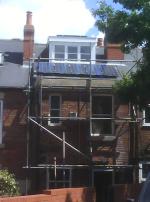A case study in renewable energy installation in Sharrow Street Sheffields (South Yorkshire)

In 2007, we installed a 1kW photovoltaic generator on a small terraced house in Sheffield. We retrace hereafter the steps in carrying out this project typical of a domestic installation.
From the preliminary site survey, our engineers were able to calculate the estimated energy yield from a suitable system, taking into account the orientation and pitch of the roof, combined with data supplied for average hours of sunlight for the particular location. Special consideration must be given to any potential shading of the array as this will reduce the energy yield dramatically.
Once these preliminary calculations were achieved, it could then be determined how large an array may be fitted to the roof area. In this particular case the space available for the solar panels was limited due to a dormer window. This was not a problem. Because the array was made up of smaller individual modules, it could be split to cover different areas of the roof. For this house, part of the array was located on top of the flat roof above the dormer window, with the rest located below covering the slates.
Other factors affecting the installation were also determined, such as the location of the inverter, (the device that converts the solar array voltage into mains voltage) and all necessary cable runs.
When the area of the array had been determined, full load bearing and wind uplift calculations were calculated and a set of plans were submitted to the local Building Control department in order to confirm that the proposed installation complied with the current Building Regulations.
Our scaffolders could then assess the level of access required for the installation work and supply a suitable system.
At this stage we provided the owner with a full quote and details of the entire installation work to be undertaken with which he could apply for a grant through the low carbon buildings programme administered by BERR (formerly DTI). http://www.lowcarbonbuildings.org.uk/how/householders/
Once the grant application was approved, work could commence. The installation time taken depends largely on access. For an easily accessible roof and inverter location, installation work will take two days for a system of this size with a day either side of this to allow for the scaffold erection and dismantling. Larger systems may take slightly longer due to the increased amount of roof mounting points that need to be installed.

